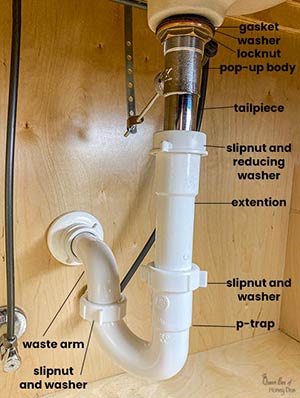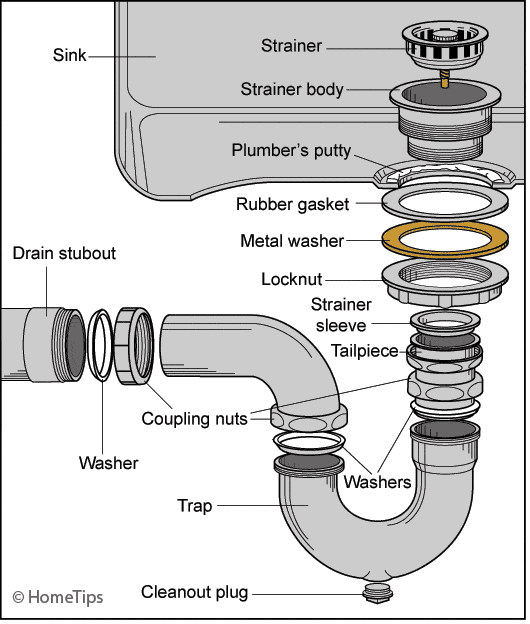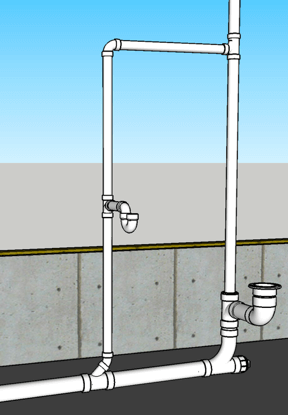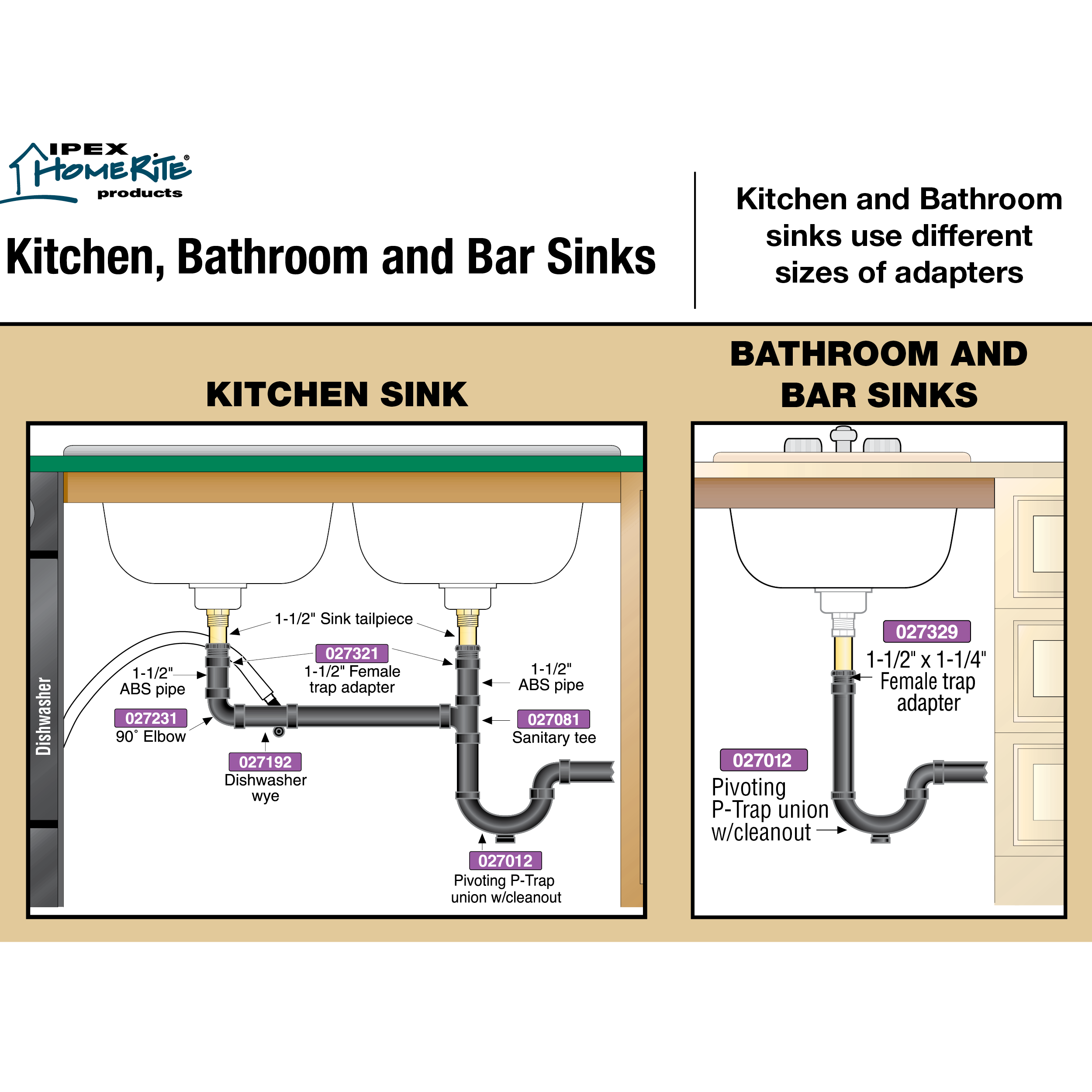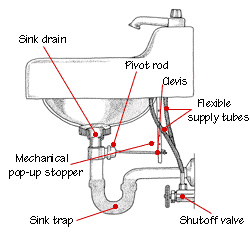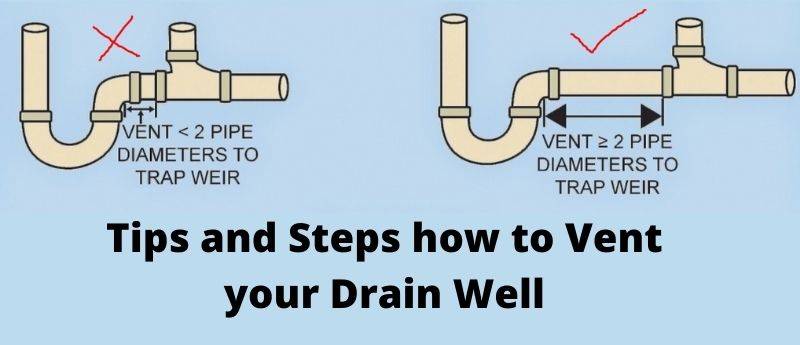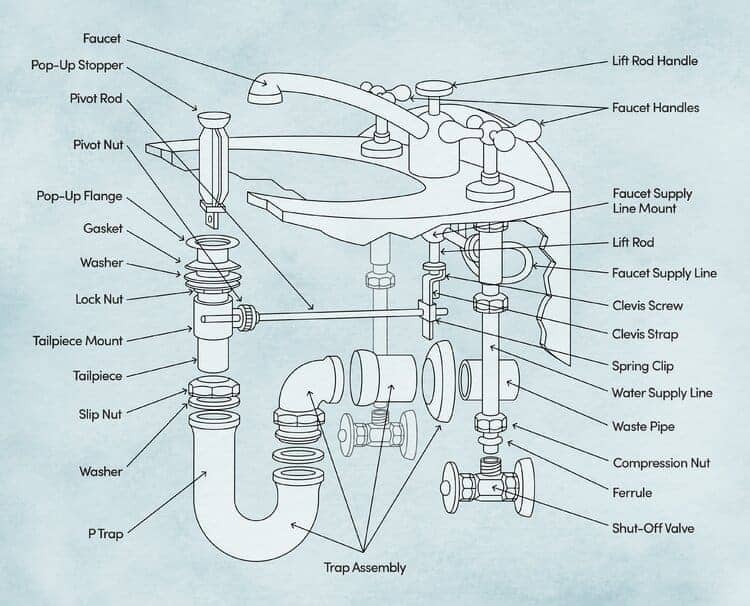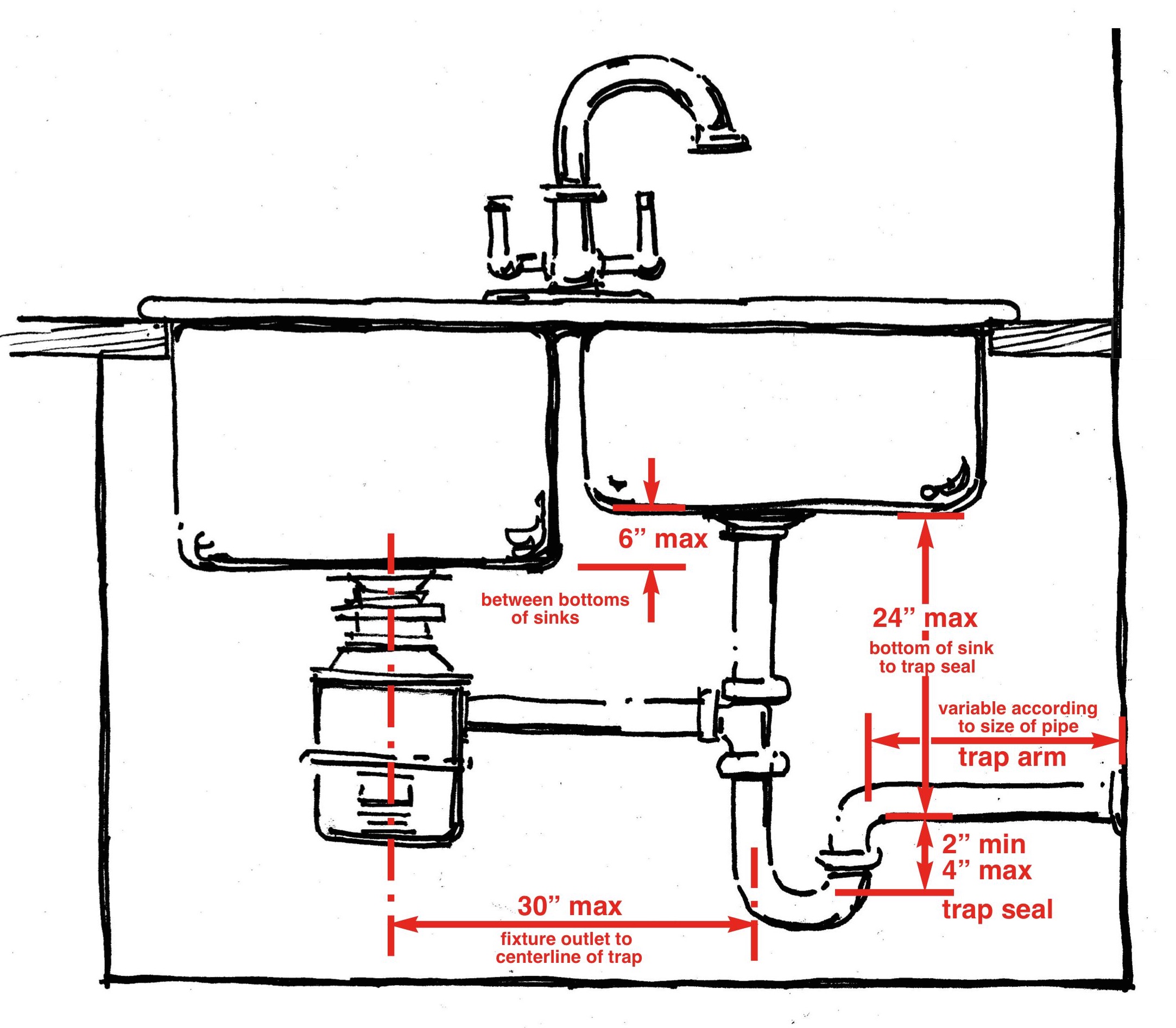Understanding the plumbing beneath your bathroom sink is essential for both homeowners and DIY enthusiasts, as it can help you troubleshoot common issues and even undertake minor repairs. In this comprehensive guide, we will explore a bathroom sink drain plumbing diagram to provide you with a clear understanding of how the plumbing works.
P-Trap: At the heart of the bathroom sink’s drain system is the P-trap. It is called a P-trap because it resembles the letter “P” when viewed from the side. This curved pipe, typically made of PVC or metal, serves two crucial functions. Firstly, it prevents sewer gases from entering your bathroom by creating a water seal. Secondly, it acts as a trap for debris that may enter the drain, preventing clogs deeper in the plumbing system. The P-trap is connected to the tailpiece of the sink and the horizontal drainpipe leading to the main drain line.
Tailpiece: The tailpiece is a short, straight section of pipe that extends downward from the sink drain. It connects the sink to the P-trap. The tailpiece is usually adjustable in length to accommodate variations in sink height and drainpipe alignment. It may have a flanged end that attaches to the sink strainer and a slip-joint nut that connects it to the P-trap. Understanding the tailpiece is crucial when it comes to adjusting the height of your sink’s drain assembly.
Sink Strainer: The sink strainer is the visible component of the sink’s drain system. It’s the round, perforated piece that fits into the sink’s drain opening. The strainer captures large debris and prevents it from entering the drainpipe. It is secured to the sink with a locknut from beneath. Over time, the strainer may become clogged with debris and require cleaning or replacement. Knowing how to remove and install a sink strainer is a valuable skill for maintaining your bathroom sink.
Drainpipe: The horizontal section of the drainpipe connects the P-trap to the main drain line. It is typically made of PVC or metal and may be connected to the P-trap using a slip-joint nut. The drainpipe carries wastewater from the sink to the main plumbing system. Understanding the drainpipe’s alignment and angle is essential for ensuring proper drainage and preventing leaks.
Vent Pipe: In a bathroom sink drain system, a vent pipe is essential to prevent airlocks and maintain proper water flow. The vent pipe connects to the main drain line and extends through the roof of the house. It allows air to enter the plumbing system, equalizing pressure and preventing water from siphoning out of the P-trap. Understanding the venting in your bathroom sink plumbing is crucial for preventing drainage issues and ensuring your plumbing system functions correctly.
A bathroom sink drain plumbing diagram provides a valuable visual representation of how the components work together to facilitate proper drainage and prevent common issues like clogs and odors. Whether you’re a homeowner or a DIY enthusiast, having a good understanding of the P-trap, tailpiece, sink strainer, drainpipe, and vent pipe can save you time and money on repairs and maintenance. It’s essential to maintain a functional and clean plumbing system beneath your bathroom sink for a hassle-free and pleasant bathroom experience.
How to Fix a Leaky Sink Trap – HomeTips
There are five major types of bathroom sinks you can choose from for your bathroom. You also want to ensure the material of your area very best matches the materials used in the remainder of the bathroom of yours. There is no point choosing your dream bathroom sink, only to find it doesn’t fit in, or alternatively it looks too tiny within your bathroom.
How To Plumb a Bathroom (with multiple plumbing diagrams
Bathroom Sink Plumbing Diagram DIY Pinterest Sinks Bathroom sink
Here are some tips to prepare you in choosing the correct sink for your bathroom. Many folks are fans of a cup sink, that can look incredibly stylish in the proper bathroom, but look out of position in a differently styled bathroom. Stainless steel for instance is easy to clean but certainly will dent.
Types of Plumbing Traps and How They Work – BestLife52
Kitchen, bathroom, and bar sink drainage
Parts of a Sink
Sink u0026 Drain Plumbing
How a Sink Drain Works – Plumbing Diagrams – Plumbing Sniper
How to Vent a Kitchen Sink Drain: Steps with pipe Diagrams
Types of Plumbing Traps and How They Work – BestLife52
20 Bathroom Sink Drain Parts: How They Works?
What are the code requirements for layout of drain piping under sinks?
Related articles:
- Bathroom Sink Cabinets Modern
- Rustic Bathroom Sink Ideas
- Bathroom Sink Storage Ideas
- Farmhouse Bathroom Sink Ideas
- Bathroom Sinks Blue
- Bathroom Sink 400mm
- Ada Bathroom Sink Dimensions
- Bathroom Sink Marble Countertop
- Bathroom Sink Design Ideas
- Bathroom Sink Pipe Leak Repair
Bathroom Sink Drain Plumbing Diagram: A Comprehensive Guide
The bathroom sink is one of the most important fixtures in your bathroom and its drain must be properly installed to ensure proper drainage. A plumbing diagram for a bathroom sink drain can help you get started on the installation process and ensure that all parts are connected correctly. In this article, we will discuss how to read a plumbing diagram for a bathroom sink drain and answer some commonly asked questions about the installation process.
What is a Bathroom Sink Drain Plumbing Diagram?
A plumbing diagram for a bathroom sink drain is a drawing that outlines the components and connections involved in the installation of a bathroom sink and its drainage system. This diagram shows the various pipes, fittings, and valves that need to be connected in order to complete the installation. It also includes instructions on how to properly connect the components and provides an overview of the entire process.
How Do You Read a Bathroom Sink Drain Plumbing Diagram?
Reading a plumbing diagram for a bathroom sink drain can be tricky at first, but once you familiarize yourself with the different parts and their functions, it becomes much easier. When you look at the diagram, you will see a series of pipes, fittings, and valves that need to be connected in order to complete the installation. Each pipe or fitting has an arrow pointing towards it indicating which direction it should be connected in order to complete the installation correctly. Additionally, each pipe or fitting will have numbers or letters next to them which indicate what size they should be or what type of material they are made out of. Once you understand these symbols, reading a plumbing diagram for a bathroom sink drain becomes much simpler.
What Parts Are Needed for Installing a Bathroom Sink Drain?
When it comes to installing a bathroom sink drain, there are several parts that must be included in order for the installation to be successful. The most common parts include:
– P-Trap: A P-trap is responsible for catching any debris before it goes down the drain and prevents it from clogging up your pipes. It consists of two curved pieces of pipe with an opening in between them where water can pass through freely while any debris gets trapped inside.
– Trap Adapter: This is used to connect the P-trap to your main waste line in order to allow water to flow freely through your pipes without getting clogged up by debris.
– Waste Line: This is usually a flexible PVC pipe that connects your main waste line to your P-trap in order to allow water to freely flow through your pipes without getting clogged up by debris.
– Overflow Pipe: An overflow pipe is responsible for allowing excess water out of your sink if it begins to fill up too much due to clogged drains or other causes. It typically runs from near the top of your sink down into your P-Trap connection where it can safely exit without causing any issues or damage.
– Supply Lines: The supply lines are responsible for supplying hot and cold water from your main water supply line into your sink’s faucet so you can use it when needed. They typically consist of two flexible metal hoses with shut off valves attached on either end so you can control the flow of water when needed.
How Do You Install A Bathroom Sink Drain?
Installing a bathroom sink drain requires careful attention and precision as mistakes can lead to major problems down the road such as leaks or clogged drains. The general steps involved in installing a bathroom sink drain are as follows:
1) Connect Your P-Trap: First, you will need to connect your P-trap by attaching one end onto the tailpiece coming off of your sink’s basin while connecting the other side directly onto your waste line using an appropriate trap adapter fitting if necessary. Make sure all connections are securely tightened before moving on to the next step.
2) Connect Your Overflow Pipe: Next, you will need to connect your overflow pipe by attaching one end onto the overflow elbow coming off of your sink’s basin while connecting the other side directly onto your waste line using an appropriate fitting if necessary. Again, make sure all connections are securely Tightened before moving on to the next step.
3) Connect Your Supply Lines: Finally, you will need to connect your supply lines to your sink’s faucet by attaching one end of each line onto the shut off valves located underneath your sink while connecting the other side directly onto the faucet inlet. Make sure all connections are securely tightened before testing out the drain and faucet for any leaks or problems.
What size pipe is typically used for a bathroom sink drain?
Most bathroom sink drains use a 1 1/2″ or 1 1/4″ diameter pipe. This size is small enough to fit underneath the sink, but large enough to accommodate a good flow of water.

